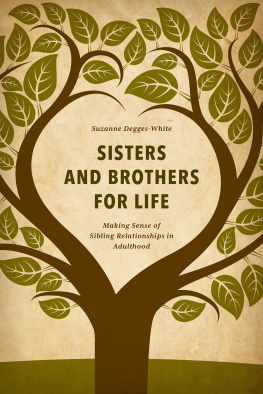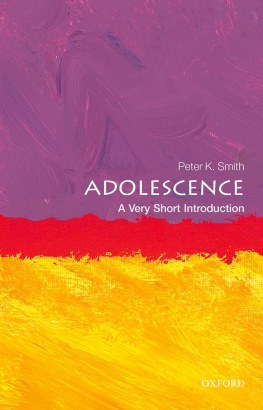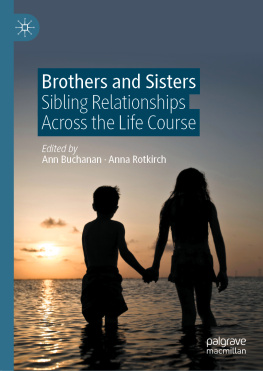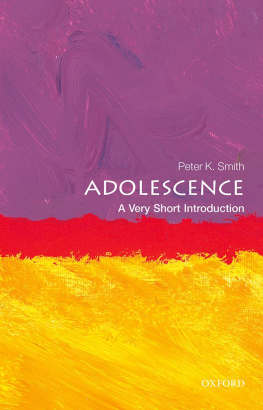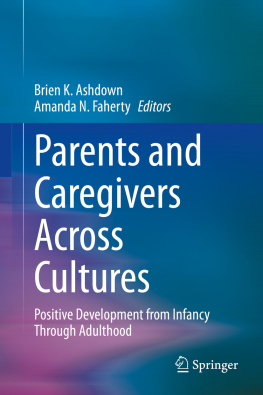Relationship
Pathways
This book is dedicated to Duane Buhrmester (19522010).
Relationship
Pathways
From Adolescence to Young Adulthood
Brett Laursen
Florida Atlantic University
W. Andrew Collins
University of Minnesota
Editors


FOR INFORMATION:
SAGE Publications, Inc.
2455 Teller Road
Thousand Oaks, California 91320
E-mail:
SAGE Publications Ltd.
1 Olivers Yard
55 City Road
London EC1Y 1SP
United Kingdom
SAGE Publications India Pvt. Ltd.
B 1/I 1 Mohan Cooperative Industrial Area
Mathura Road, New Delhi 110 044
India
SAGE Publications Asia-Pacific Pte. Ltd.
33 Pekin Street
#02-01 Far East Square
Singapore 048763
Acquisitions Editor: Vicki Knight
Associate Editor: Lauren Habib
Editorial Assistant: Kalie Koscielak
Production Editor: Eric Garner
Copy Editor: Megan Markanich
Typesetter: C&M Digitals (P) Ltd.
Proofreader: Laura Webb
Indexer: Jean Casalegno
Cover Designer: Candice Harman
Marketing Manager: Liz Thornton
Permissions Editor: Adele Hutchinson
Copyright 2012 by SAGE Publications, Inc.
All rights reserved. No part of this book may be reproduced or utilized in any form or by any means, electronic or mechanical, including photocopying, recording, or by any information storage and retrieval system, without permission in writing from the publisher.
Printed in the United States of America
Library of Congress Cataloging-in-Publication Data
Relationship pathways : from
adolescence to young adulthood / Brett Laursen, W. Andrew Collins, editors.
p. cm.
Includes bibliographical references and index.
ISBN 978-1-4129-8739-4 (pbk.)
1. Adolescence. 2. Adolescent psychology. 3. TeenagersFamily relationships. 4. TeenagersSexual behavior. 5. Interpersonal relations. I. Laursen, Brett Paul. II. Collins, W. Andrew, 1944- BF724.R393 2012
155.5dc23 2011031176
This book is printed on acid-free paper.
11 12 13 14 15 10 9 8 7 6 5 4 3 2 1
Brief Contents
Preface
Brett Laursen
1. Transformations in Close Relationship Networks: ParentChild Relationships and Their Social Extensions
W. Andrew Collins, K. Lee Raby, Jos M. Causadias
2. Transformations in ParentChild Relationships From Adolescence to Adulthood
Nancy L. Galambos, Lauren A. Kotylak
3. Transformations in Sibling Relationships From Adolescence to Adulthood
Lilly Shanahan, Evelyn B. Waite, Timothy W. Boyd II
4. Transformations in Friend Relationships Across the Transition Into Adolescence
Christopher A. Hafen, Brett Laursen, Dawn DeLay
5. Transformations in Friend Relationships Across the Transition Into Adulthood
Chong Man Chow, Holly Roelse, Duane Buhrmester, Marion K. Underwood
6. Adolescent Friendship Bonds in Cultures of Connectedness
Barry H. Schneider, Matthew D. Lee, Ibis Alvarez-Valdivia
7. Transformations in Adolescent Peer Networks
Ren Veenstra, Jan Kornelis Dijkstra
8. Transformations in Heterosexual Romantic Relationships Across the Transition Into Adolescence
Inge Seiffge-Krenke, Shmuel Shulman
9. Transformations in Heterosexual Romantic Relationships Across the Transition Into Adulthood: Meet Me at the Bleachers I Mean the Bar
Wyndol Furman, Jessica K. Winkles
10. The Development of Same-Sex Intimate Relationships During Adolescence
Stephen T. Russell, Ryan J. Watson, Joel A. Muraco
11. Gene-Environment Interplay in Adolescent Relationships
Kirby Deater-Deckard, Zhe Wang
12. Interpersonal and Intrapersonal Processes in the Development of Adolescent Relationships
Susan Branje, Loes Keijsers, Muriel van Doorn, Wim Meeus
13. The Role of Gender in Transformations in Adolescent Relationships
Amanda J. Rose, Rhiannon L. Smith, Gary C. Glick, Rebecca A. Schwartz-Mette
Detailed Contents
Preface
Brett Laursen
1. Transformations in Close Relationship Networks: ParentChild Relationships and Their Social Extensions
W. Andrew Collins, K. Lee Raby, Jos M. Causadias
2. Transformations in ParentChild Relationships From Adolescence to Adulthood
Nancy L. Galambos, Lauren A. Kotylak
3. Transformations in Sibling Relationships From Adolescence to Adulthood
Lilly Shanahan, Evelyn B. Waite, Timothy W. Boyd II
4. Transformations in Friend Relationships Across the Transition Into Adolescence
Christopher A. Hafen, Brett Laursen, Dawn DeLay
5. Transformations in Friend Relationships Across the Transition Into Adulthood
Chong Man Chow, Holly Roelse, Duane Buhrmester, Marion K. Underwood
6. Adolescent Friendship Bonds in Cultures of Connectedness
Barry H. Schneider, Matthew D. Lee, Ibis Alvarez-Valdivia
7. Transformations in Adolescent Peer Networks
Ren Veenstra, Jan Kornelis Dijkstra
8. Transformations in Heterosexual Romantic Relationships Across the Transition Into Adolescence
Inge Seiffge-Krenke, Shmuel Shulman
9. Transformations in Heterosexual Romantic Relationships Across the Transition Into Adulthood: Meet Me at the Bleachers I Mean the Bar
Wyndol Furman, Jessica K. Winkles
10. The Development of Same-Sex Intimate Relationships During Adolescence
Stephen T. Russell, Ryan J. Watson, Joel A. Muraco
11. Gene-Environment Interplay in Adolescent Relationships
Kirby Deater-Deckard, Zhe Wang
12. Interpersonal and Intrapersonal Processes in the Development of Adolescent Relationships
Susan Branje, Loes Keijsers, Muriel van Doorn, Wim Meeus
13. The Role of Gender in Transformations in Adolescent Relationships
Amanda J. Rose, Rhiannon L. Smith, Gary C. Glick, Rebecca A. Schwartz-Mette
Preface
A decade ago, we proposed a musical analogy to describe changes in close relationships across the second decade of life. We argued that relationship development during these years resembles a fugue (Collins & Laursen, 2000). A fugue is a musical composition characterized by distinct melodic themes that are elaborated successively and interwoven to create a single, well-defined structure. Close relationships across the years that span the transition into and out of adolescence follow an analogous pattern. Affiliations with friends, romantic partners, siblings, and parents unfold along varied and discrete trajectories for much of this time and then coalesce during the early 20s into integrated interpersonal structures.
Our views are informed by two influential depictions of development. The first is Hartups (1979) depiction of the emergence of unique social worlds during childhood. In this view, family and peer relationships are two social worlds that develop increasingly independent of one another as children spend more time out of the home and in school and other peer-dominated contexts. The second is Werners (1957) thesis that development proceeds from a state of globality to a state of increasing differentiation and hierarchic differentiation.
Relationships provide an essential context for human development. Social experiences are organized around relationships (Hartup & Laursen, 1999). We contend that close relationships are global and undifferentiated during the early years of life. Distinctions between family members first emerge as different patterns of interaction are established with mothers, fathers, and siblings that promote the acquisition of a diverse set of skills and abilities. The peer social world emerges from this context. Most early friendships are formed with playmates under the supervision of family members. Gradually, however, different principles come to govern exchanges with peers and those with family members, and the interactions in these relationships change accordingly (Laursen & Bukowski, 1997). By the end of childhood, families and peers occupy two distinct social worlds.
Next page


